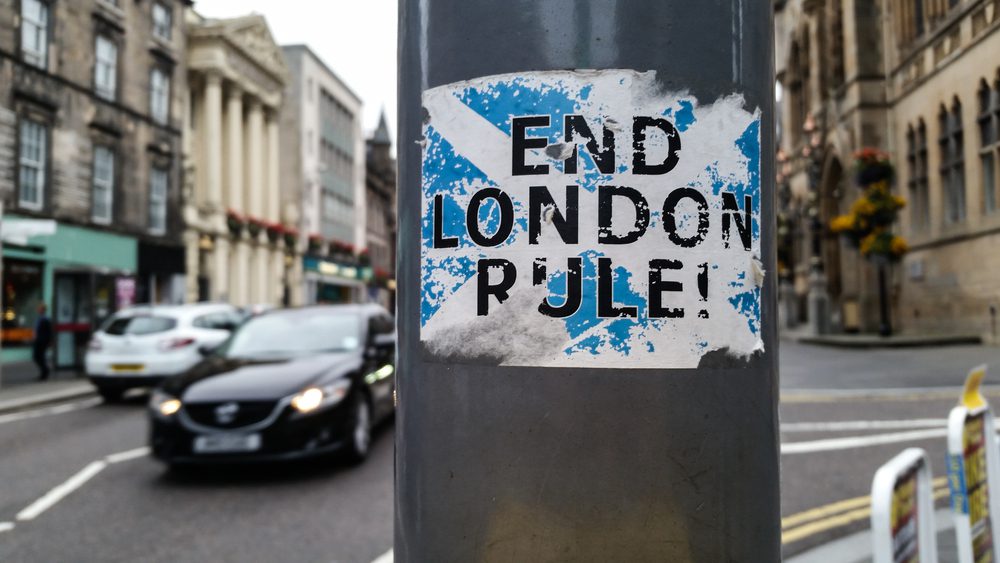Next Tuesday, June 28th, Scottish First Minister Nicola Sturgeon (SNP) will declare her ‘routemap’ towards a second Scottish independence referendum, The Herald reports. It is the center-left Scottish National Party’s aim for ‘Indyref2,’ as it is called, to be held in October of next year.
For Sturgeon it is another crack at independence, after a previous attempt in 2014 did not bring sufficient votes to leave the Union. It was on June 17th that she relaunched her “refreshed” case, as her party laments the fact that other European countries of Scotland’s size are outperforming a post-Brexit UK in key areas. While Westminster is unwilling to grant Sturgeon the necessary powers (under Section 30 of the Scotland Act 1998) once more, she appears eager to deliver on her party’s commitment to the cause—with or without the requisite legal authorisation . There may well be a slugging match on the point between the devolved Scottish ministry headed by Sturgeon and the UK Government at the Supreme Court.
To gain greater popular consent, as well as to build momentum, the Scottish government’s website recently released the first of what will be a series of papers. Titled ‘Independence in the modern world. Wealthier, happier, fairer: why not Scotland?’ these papers will, according to Sturgeon, “answer key questions about the transition to independence and the infrastructure that will be required for the effective governance of an independent country,” so “that the choice people make on independence will be an informed one.”
Since 2014, Scotland has instituted its own tax and social security agencies, as well as an independent Scottish Fiscal Commission and a Scottish National Investment Bank, both of which Sturgeon calls “substantial parts of the institutional infrastructure that an independent country would need.”
She concludes:
We are a brilliant country in so many ways—but a glance at many of our European neighbors tells us we can do better. That should excite and inspire us. But first we must equip ourselves with the powers of independence that they already possess.
…
We look forward to hearing others’ views as we work together to build the better Scotland we know is possible.
As of yet, Sturgeon has not introduced a single piece of legislation for a second referendum, despite having published a two-page draft version last year. Any forthcoming bill first needs approval from the Lord Advocate, Dorothy Bain QC, who would have to determine if it could survive a challenge by the Supreme Court.
Time is also not Sturgeon’s friend. If no bill is produced before the summer recess, it cannot be published until September, which makes meeting the October 2023 deadline extremely unlikely. The First Minister’s idleness on this front has led to speculation that she realizes a Supreme Court defeat is more or less certain and that she therefore wants to turn Indyref2 into a glorified opinion poll. The strategic utility of this is hard to see, since it would dampen the spirits of those in the “Yes” movement, and make it susceptible to the Unionists’ ridicule.
Scottish appetite for a referendum in 2023 is poor. According to a recent YouGov poll, only 28% of Scots say they think there should be a referendum next year, compared to 59% who do not think there should be. Most people in Scotland, it seems, are more troubled by immediately pressing issues such as the cost of living crisis and an ailing National Health Service (NHS). On whether there should be a referendum within the next five years, the public is split (42%/41%). However, while most have no stomach for an actual holding of a referendum next year, 45% of those queried took a liking to the notion of independence, while 55% were against. This was the exact same margin when the campaign for Scottish independence lost in the 2014 referendum.
Amongst the political class, the proposal is highly unpopular with Tories especially. On this matter at least, the Scottish Conservatives echo the public’s current mood:
Next week, Nicola Sturgeon will waste more parliamentary time with a statement on independence.
— Scottish Conservatives (@ScotTories) June 21, 2022
The Scottish public are sick of the SNP’s obsession with another divisive referendum.
Join our campaign to tell Sturgeon to give it a rest 👉https://t.co/VbvO62KEVE pic.twitter.com/DY6Xic49B9






